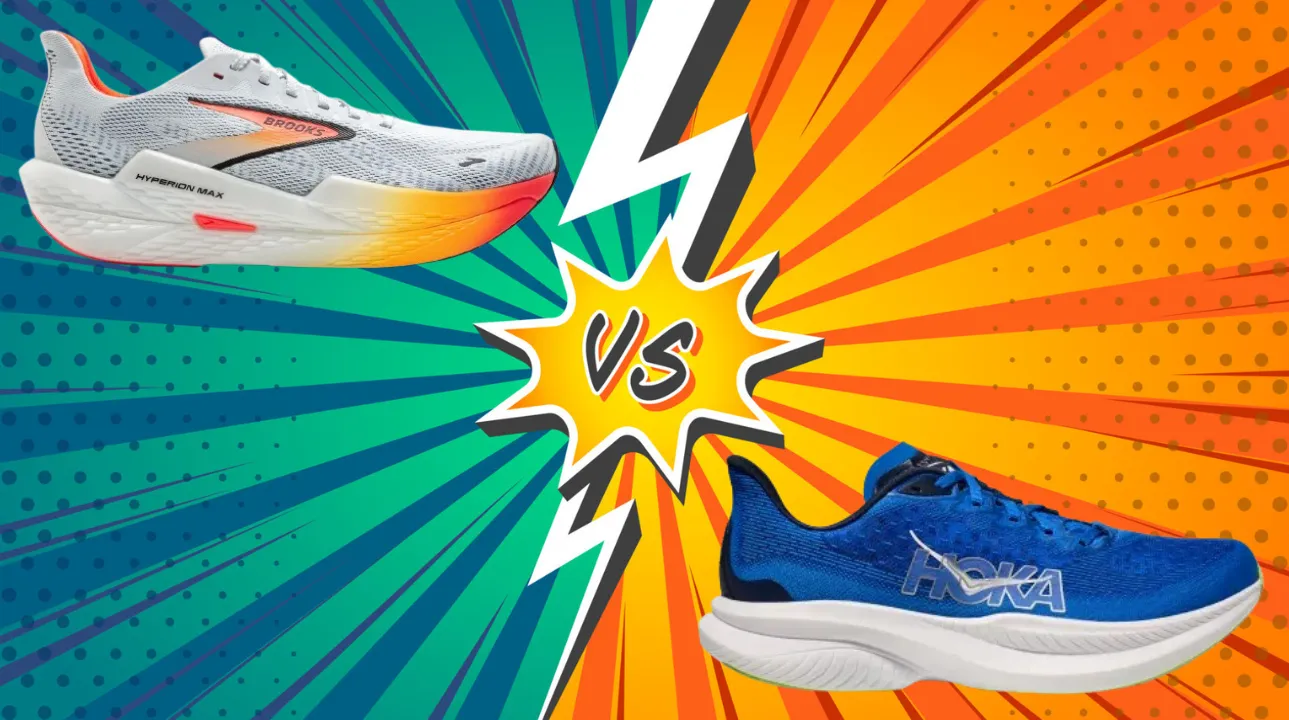Lace up, runners! We’re diving into an exciting face-off between two top-tier running shoes: the Brooks Hyperion Max 2 and the Hoka Mach 6. Both promise speed and comfort, but which one will cross the finish line first in our comparison?
Whether you’re chasing PRs or looking for your next everyday trainer, this in-depth analysis will help you make the right choice for your feet. Let’s hit the ground running!
Key Takeaways:
- Cushioning Difference: The Brooks Hyperion Max 2 offers more cushioning, making it ideal for long-distance runs and high-mileage training. The Hoka Mach 6 features a firmer, more responsive cushioning better suited for speed work and shorter distances.
- Price Point: The Hoka Mach 6 is more budget-friendly at $140, while the Brooks Hyperion Max 2 is priced higher at $180. This $40 difference may be significant for some runners, especially those new to the sport or on a tighter budget.
- Weight Distinction: The Hoka Mach 6 is slightly lighter at 8.20 oz compared to the Brooks Hyperion Max 2 at 9.1 oz. This weight difference could be noticeable during longer runs or races where every ounce counts.
- Versatility: While both shoes perform well across various activities, the Hoka Mach 6 seems to offer greater versatility. Its balanced cushioning and lower profile make it suitable for both running and everyday wear, whereas the Brooks Hyperion Max 2 is more specialized for running.
- Stability Approach: Both shoes are neutral but approach stability differently. The Brooks Hyperion Max 2 relies on its wider base and responsive cushioning, while the Hoka Mach 6 uses a symmetrical cushion bed and lower profile for stability. Runners with specific stability needs should consider these differences.
Comparison Table between Brooks Hyperion Max 2 and Hoka Mach 6:
| Feature | Brooks Hyperion Max 2 | Hoka Mach 6 |
|---|---|---|
| Stability | Neutral | Neutral |
| Flexibility | Moderate | Moderate to High |
| Sizing | True to size | True to size |
| Weight | 9.1 oz / 258.0g | 8.20 oz / 232.5g |
| Cushion | More Cushioning | Balanced (Responsive to Plush) |
| Outsole | Strategic rubber coverage | Strategic rubber coverage |
| Midsole | Lightweight cushioning | Supercritical foam |
| Upper | Breathable engineered mesh | Creel jacquard |
| Retail Price | $180 | $140 |
Features Comparison:
1. MATERIAL: outsole, insole, upper sole
The Brooks Hyperion Max 2 features a strategic rubber outsole designed for durability and traction. Its midsole uses lightweight cushioning technology, providing a balance of softness and responsiveness.
The upper is constructed with a breathable engineered mesh that enhances ventilation and comfort.
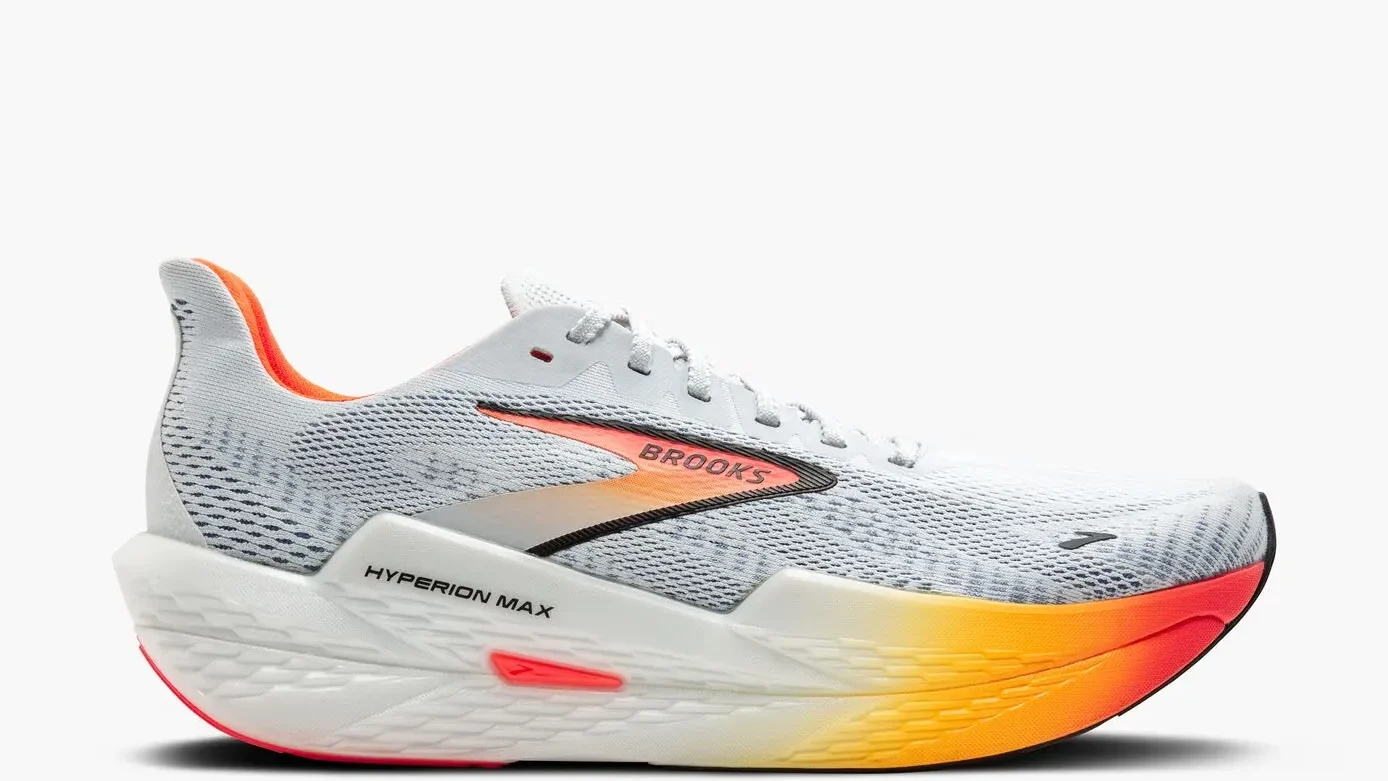
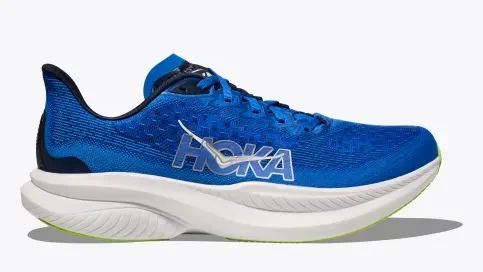
On the other hand, the Hoka Mach 6 boasts a similar strategic rubber outsole for grip and longevity. Its standout feature is the supercritical foam midsole, known for its responsiveness and energy return.
The upper utilizes a creel jacquard material, offering a mix of support and breathability. Both shoes prioritize lightweight materials to enhance speed and performance.
2. Durability:
When it comes to durability, the Brooks Hyperion Max 2 is built to last. Its strategic rubber placement on high-wear areas of the outsole helps protect against premature wear.
The engineered mesh upper is designed to withstand the rigors of regular training while maintaining its shape and support.
The Hoka Mach 6 also scores high on durability. Its rubber outsole coverage, though strategic, provides good protection against wear and tear. The supercritical foam midsole is known for its resilience, maintaining its performance characteristics over time.
However, some users report that the lightweight nature of both shoes might slightly compromise long-term durability compared to heavier, more traditional running shoes.
3. Fit:
The Brooks Hyperion Max 2 is praised for its true-to-size fit. It features a streamlined design that hugs the foot comfortably without feeling restrictive.
The engineered mesh upper adapts to different foot shapes, providing a snug yet accommodating fit. The heel collar and tongue are well-padded, enhancing overall comfort and preventing slippage.
Similarly, the Hoka Mach 6 offers a true-to-size fit with some unique features. Its streamlined collar foam package and anatomical tongue design contribute to a secure and comfortable fit.
The dual internal gusset helps keep the tongue in place and provides additional midfoot support. Both shoes cater well to a variety of foot shapes, but the Mach 6 might feel slightly more secure in the midfoot area.
4. Cushioning:
Cushioning is where these shoes start to differentiate themselves. The Brooks Hyperion Max 2 features more cushioning than its predecessor, placing it in the higher cushion category.
It aims to provide a plush, protective ride without sacrificing responsiveness. The high-stacked cushioning is designed to absorb impact and provide energy return, making it suitable for both long runs and speed work.
The Hoka Mach 6, while still well-cushioned, takes a slightly different approach. It features a low-profile cushion bed that keeps your foot closer to the ground.
The supercritical foam midsole is designed to be responsive and firm, providing an efficient push-off. This places the Mach 6 in a more balanced cushion category, aiming for a mix of comfort and speed.
5. Stability:
Both shoes are categorized as neutral runners, but they approach stability differently. The Brooks Hyperion Max 2 achieves stability through its overall design rather than specific stability features.
The wider base and the responsive cushioning work together to provide a stable ride, suitable for neutral runners or those needing just a touch of support.
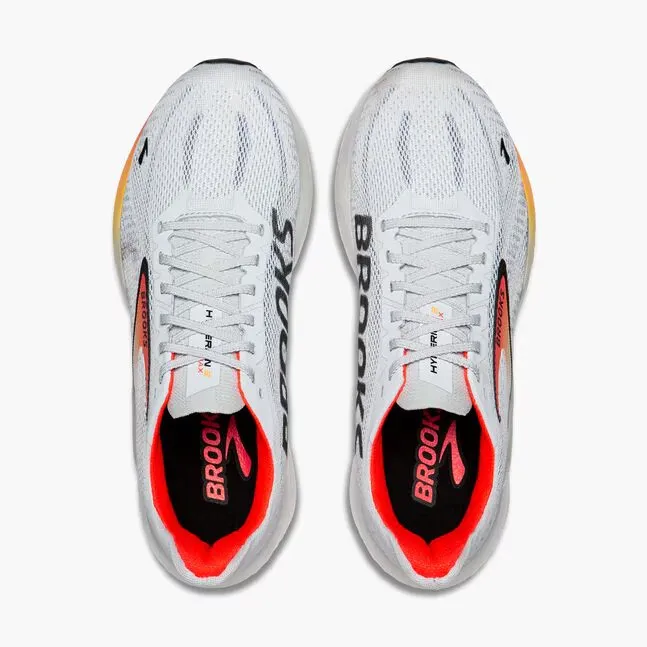
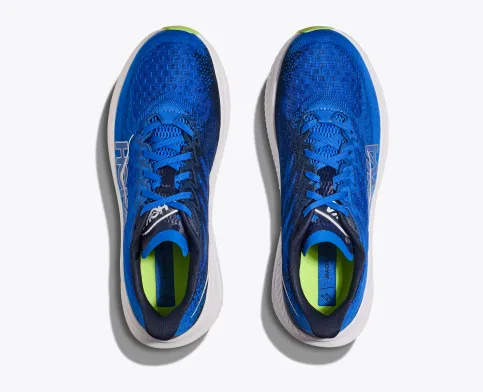
The Hoka Mach 6 takes a similar approach with its symmetrical bed of cushion without additional prescriptive technologies. It’s designed to provide the support you need without unnecessary features.
The low-profile design and firmer midsole contribute to its stability, potentially making it slightly more stable than the Hyperion Max 2, especially during faster runs.
6. Value for Money:
At $180, the Brooks Hyperion Max 2 sits at a higher price point. However, it justifies this with its advanced cushioning technology, versatile performance, and durable construction. It’s positioned as a premium shoe for runners who prioritize cushioning and are willing to invest in their running gear.
The Hoka Mach 6, priced at $140, offers excellent value. It provides many high-end features, including the supercritical foam midsole and thoughtful fit elements, at a more accessible price point. For runners looking for a balance of performance and cost-effectiveness, the Mach 6 presents a compelling option.
Performance Comparison:
1. For Walking:
For walking, both shoes offer comfort but in different ways. The Brooks Hyperion Max 2’s higher cushioning provides a plush experience, absorbing impact effectively during long walks.
Its breathable upper ensures comfort even during extended wear. However, some may find it slightly overbuilt for casual walking.
The Hoka Mach 6, with its lower profile and firmer cushioning, offers a more grounded walking experience. Its responsive midsole provides good energy return, potentially reducing fatigue during longer walks.
The streamlined design makes it feel less bulky for everyday use. For pure walking purposes, the Mach 6 might have a slight edge due to its versatility and lower weight.
2. For Running:
When it comes to running, both shoes shine but cater to slightly different preferences. The Brooks Hyperion Max 2 excels in longer runs and training sessions.
Its higher cushioning stack provides excellent impact protection, making it ideal for high-mileage training. The shoe’s design promotes fast transitions, suitable for tempo runs and race preparation.
The Hoka Mach 6 leans more towards speed work and shorter to medium-distance runs. Its firmer, more responsive midsole delivers quick energy return, favoring faster paces.
The lower profile design promotes a more natural stride and quicker turnover. For runners focusing on speed and efficiency, particularly in races or interval training, the Mach 6 might have an advantage.
3. Standing All Day:
For all-day standing, comfort and support are crucial. The Brooks Hyperion Max 2 shines here with its generous cushioning. The high-stacked midsole provides excellent shock absorption, potentially reducing fatigue during long periods of standing.
However, its running-specific design might feel a bit unstable for some in non-running contexts.
The Hoka Mach 6, while less cushioned, offers a different kind of all-day comfort. Its firmer, more responsive cushioning might provide better support over extended periods.
The lower profile could offer more stability for standing. The lightweight design is a bonus for reduced foot fatigue. For pure standing comfort, it’s a close call, but the Mach 6 might edge out due to its versatility and stability.
4. Plantar Fasciitis:
For runners dealing with plantar fasciitis, cushioning and support are key. The Brooks Hyperion Max 2’s higher cushioning stack could provide excellent shock absorption,
Potentially alleviating some pain associated with plantar fasciitis. The shoe’s design promoting fast transitions might help reduce stress on the plantar fascia.
The Hoka Mach 6, while less cushioned, offers firm support that some plantar fasciitis sufferers might prefer. Its responsive midsole could promote a more natural foot movement, potentially beneficial for some cases.
The lower heel-to-toe drop (5mm vs 6mm in the Hyperion Max 2) might also help reduce strain on the plantar fascia. Ultimately, the best choice would depend on individual needs and preferences, with both shoes offering potential benefits.
Conclusion:
Choosing between the Brooks Hyperion Max 2 and Hoka Mach 6 ultimately depends on your running style and preferences. If you prioritize cushioning and don’t mind a slightly higher price, the Hyperion Max 2 is an excellent choice for long runs and high-mileage training.
Its plush ride and protective design make it ideal for those seeking comfort over extended distances. For those seeking a versatile, responsive shoe for faster runs and races at a more budget-friendly price, the Mach 6 stands out.
Its firmer, more responsive cushioning and lower profile design cater to speed-focused runners and those preferring a more connected feel with the ground. Both shoes offer quality construction and innovative technologies, making them strong contenders in their respective categories.
Consider your primary use case, budget, and personal comfort preferences when making your decision. If possible, try both on to get a real feel for which shoe aligns best with your running needs.

